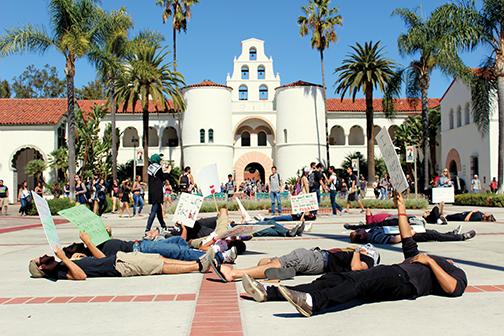
Imagine witnessing the death of innocent people all around you. Now, imagine being a family member of one of the victims in Gaza. On Thursday, Oct. 2, Students for Justice in Palestine held a die-in protest on Campanile Walkway. SJP co-chair Osama Alkhawaja explained this protest was intended to spread awareness in honor of the victims of violence that occurred in Gaza this summer.
A circle was formed and those who participated laid in the middle stimulating being dead as Alkhawaja read the names of the victims. Approximately 35 names were read to rattle onlookers with hopes of making them realize what it would be like to be in Gaza.
This kind of protest might be shocking to some, but it’s rather effective. This die-in protest is everything all protests need: display of action, or a visual representation, of what could be happening in the comfort of one’s own city. Oftentimes, people cling to what they see rather than what they hear, so this protest hits right at the heart of witnesses.
Not everything can be promoted through tabling and SJP clearly understood that when they decided on this type of protest. The idea is to captivate those who are curious by opening their eyes to the truth. Bias in the media creates disagreement, but unless an individual is in Gaza, it’s hard to know what’s actually going on.
Protests like these bring us back to the real roots of why there’s fighting: We’re fighting for justice and peace all around the world, not just Gaza. We’re commemorating those victims who didn’t realize they would lose their lives. There are protests because there are wrongdoings.
There’s a strong shock and emotional value driving this protest. The most effective protests are the ones that trigger emotion and increase mindfulness.
This new technique is effective because it paints a picture of the cruelty that’s not portrayed in the media accurately.
This same demonstration was done at the Hollywood Walk of Fame when a peace protester pretended to be dead, lying on the ground with a sign saying, “Nothing to see here, just another dead Palestinian. Keep moving.” How can someone ignore words placed so nonchalantly, yet so powerful?
Immediately, the eyes of those surrounding, mostly tourists, veer toward this gruesome scene. Die-in protests create an uproar of emotions and stir controversy with the idea the results will have an impact on others. There is no way a display that real can be looked away from.
“The reason for the die-in is to display not only what has happened—of all the people who have died—but it’s also to shock people,” Christian Benavides, who participated in the die-in, said. “This is what you would have seen in Gaza.”
Additionally, SJP spreads posters with pictures and information of victims who have lost their lives in Gaza. The pictures were of the victims when they were alive, as a way to honor their memory.
Rather than destroying the memories of the deceased with terrible images after their attacks, pictures from the past create a safe environment where these victims can be honored. Because these images attract students, SJP’s hopes it can educate the campus of the current issues happening in Palestine and Israel. Transforming protests to effective die-ins bring the fight directly to campus, creating a more realistic circumstance.
It’s impossible to ignore a sight when our own peers are pretending to be dead. It goes to show the best effort is the one staring directly at us, no matter how difficult it is to deal with. The message remains the same, but this action gets people to listen.
Check out the counter argument here.






